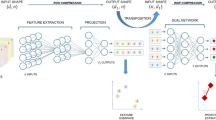Abstract
In this paper, we propose a new information-theoretic method called enhancement and relaxation to discover main features in input patterns. We have so far shown that competitive learning is a process of mutual information maximization between input patterns and connection weights. However, because mutual information is an average over all input patterns and competitive units, it is not adequate for discovering detailed information on the roles of elements in a network. To extract information on the roles of elements in a networks, we enhance or relax competitive units through the elements. Mutual information should be changed by these processes. The change in information is called enhanced information. The enhanced information can be used to discover features in input patterns, because the information includes detailed information on elements in a network. We applied the method to the symmetry data, the well-known Iris problem and the OECD countries classification. In all cases, we succeeded in extracting the main features in input patterns.
Similar content being viewed by others
Explore related subjects
Discover the latest articles, news and stories from top researchers in related subjects.References
Ahalt SC, Krishnamurthy AK, Chen P, Melton DE (1990) Competitive learning algorithms for vector quantization. Neural Netw 3: 277–290
Bell AJ, Sejnowski TJ (1995) An information-maximization approach to blind separation and blind deconvolution. Neural Comput 7(6): 1129–1159
Deco G, Finnof W, Zimmermann HG (1995) Unsupervised mutual information criterion for elimination of overtraining in supervised multiplayer networks. Neural Comput 7: 86–107
DeSieno D (1988) Adding a conscience to competitive learning. In: Proceedings of IEEE International Conference on Neural Networks, (San Diego), pp 117–124, IEEE
Erdogmus D, Principe J (2004) Lower and upper bounds for misclassification probability based on renyi’s information. J VLST Signal Process Syst 37(2/3): 305–317
Gatlin LL (1972) Information theory and living systems. Columbia University Press, New York
Gokcay E, Principe J (2002) Information theoretic clustering. IEEE Trans Pattern Anal Mach 24(2): 158–171
Gorman RP, Sejnowski TJ (1988) Analysis of hidden units in a layered network trained to classify sonar targets. Neural Netw 1: 75–89
Hulle MMV (1997) The formation of topographic maps that maximize the average mutual information of the output responses to noiseless input signals. Neural Comput 9(3): 595–606
Kamimura R (2003) Information-theoretic competitive learning with inverse euclidean distance. Neural Processing Letters 18: 163–184
Kamimura R (2003) Progressive feature extraction by greedy network-growing algorithm. Complex Systems 14(2): 127–153
Kamimura R (2003) Information theoretic competitive learning in self-adaptive multi-layered networks. Connection Science 13(4): 323–347
Kamimura R (2006) Unifying cost and information in information-theoretic competitive learning. Neural Netw 18: 711–718
Kamimura R (2006) Cooperative information maximization with gauissian activation functions for self-organizing maps. IEEE Trans Neural Netw 17(4): 909–919
Kamimura R (2006) Improving information-theoretic competitive learning by accentuated information maximization. Int J Gen Syst 34(3): 219–233
Kamimura R, Kamimura T, Uchida O (2001) Flexible feature discovery and structural information. Connection Science 13(4): 323–347
Kamimura R, Kamimura T, Takeuchi H (2002) Greedy information acquisition algorithm: a new information theoretic approach to dynamic information acquisition in neural networks. Connection Science 14(2): 137–162
Karnin ED (1990) A simple procedure for pruning back-propagation trained networks. IEEE Trans Neural Netw 1(2): 239–242
Kaski S, Nikkilä J, Kohonen T (1998) Methods for interpreting a self-organized map in data analysis. In: Verleysen M, (eds) Proceedings of ESANN’98, 6th European Symposium on Artificial Neural Networks Bruges, D-Facto, Brussels, Belgium, pp 185–190, 22–24 April
Kumagai E, Funao N (2007) Data mining by R (in Japanese). 9-Ten Publishing Company
Le Cun Y, Denker JS, Solla SA (1990) Optimal brain damage. In: Advanced in neural information processing, pp 598–605
Lehn-Schioler DET, Hegde Anant, Principe JC (2004) Vector-quantization using information theoretic concepts. Natural Comput 4(1): 39–51
Linsker R (1988) Self-organization in a perceptual network. Computer 21: 105–117
Linsker R (1989) How to generate ordered maps by maximizing the mutual information between input and output. Neural Comput 1: 402–411
Luk A, Lien S (2000) Properties of the generalized lotto-type competitive learning. In: Proceedings of International conference on neural information processing, Morgan Kaufmann Publishers, San Mateo: CA, pp 1180–1185
Micheli A, Sperduti A, Starita A. (2001) Analysis of the internal representations developed by neural networks for structures applied to quantitative structure-activity relationship studies of benzodiazepines. J Chem Inf Comput Sci 41: 202–218
Mozer MC, Smolensky P (1989) Using relevance to reduce network size automatically. Connection Science 1(1): 3–16
Reed R (1993) Pruning algorithms-a survey. IEEE Trans Neural Netw 4(5): 740–747
Rumelhart DE, Hinton GE, Williams RJ et al (1986) Learning internal representations by error progagation. In: Rumelhart DE, McClelland JL (eds) Parallel distributed processing vol.1. MIT Press, Cambridge, pp 318–362
Slonim N, Tishby N (1999) Agglomerative information bottleneck. In: Advanced in neural information processing, pp 617–623
Towell GG, Shavlik JW (1993) Extracting rules from knowledge-based neural networks. Mach Learn 13: 71–101
Torkkola K (2003) Feature extraction by non-parametric mutual information maximization. J Mach Learn Res 3: 1415–1438
Vesanto J, Alhoniemi E (2000) Clustering of the self-organizing map. IEEE-NN 11: 586
Vesanto J (1999) SOM-based data visualization methods. Intelligent-Data-Analysis 3: 111–126
Xu L (1993) Rival penalized competitive learning for clustering analysis, RBF net, and curve detection. IEEE Trans Neural Netw 4(4): 636–649
Author information
Authors and Affiliations
Corresponding author
Rights and permissions
About this article
Cite this article
Kamimura, R. Enhancing and Relaxing Competitive Units for Feature Discovery. Neural Process Lett 30, 37–57 (2009). https://doi.org/10.1007/s11063-009-9109-1
Received:
Accepted:
Published:
Issue Date:
DOI: https://doi.org/10.1007/s11063-009-9109-1




